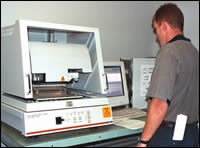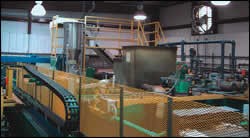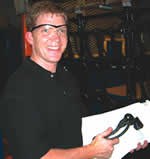Gearing Up for Automotive Finishing
Things were changing in the Southeast United States. New industries were moving in, namely, automotive. Roy Metal Finishing saw this and geared up its production lines to meet the requirements of its newest customers...
Industry in the Old South is changing. Textile mills and furniture manufacturers once ruled; however, a new leader has emerged: automotive. Roy Metal Finishing, Greenville, SC, is realizing this and is implementing changes that will help the 42-year-old company keep pace both technically and productively with this demanding industry.
According to John Pazdan, company vice president, “It became clear to us a few years ago that our automotive customers were expecting more from their outsourced operations – especially electroplating. The automotive work that has moved into the South has basically replaced the textile industry. The automotive companies have high expectations when it comes to computer controls driving the plating process, process control relating to chemistry, communication and plating innovation.” Mr. Pazdan and Cliff Roy, company president, admired the quality strategies of their European and Japanese customers and decided to pick the best quality strategies from each customer. It was quite evident that a “canned” quality package would not work at Roy Metal.
Computer Controls Driving the Plating Process
Beginning in 1997, Roy Metal began to integrate the use of programmable controllers to run automated plating lines. The next step was to include the use of computers to interface with the controllers. The new lines that were installed use bar coding technologies and touch screen MMI (man machine interface). Some existing lines were retrofitted with similar computer controls. Roy Metal has “experimented” with three different interface software manufacturers on different lines but now has settled into one system that best fits its needs. Final integration of the plating line computers to the company server gives management and customers more information. “Plating line database information is valuable as a management tool as well as to certify to customers what is being done to their parts.” stated Mr. Pazdan, “We want everyone in our organization as well as our customers to have as much information as possible.”
New rack and barrel plating lines at Roy Metal Finishing continue to be designed, engineered and installed by Roy Metal’s associate Ken Holcombe and his maintenance staff. A recent addition to the Roy Metal maintenance team is a systems integrator to oversee the interface between the computers and the plating line equipment. As mentioned, Roy Metal has worked with three interface software systems – two from the US and one from Germany. The company has since focused on software from Jessup Engineering, Inc. designed to provide the flexibility needed to meet the demands of Roy Metal’s automotive customers. Features such as individual rectifier control, auto dosing, bar code entry, recipe processing and extensive alarm system ensure that a part's finish will be consistent regardless of shift or day they were processed. Having rectifiers on individual plating cells has allowed Roy Metal to offer automotive customers repeatability that was not available before. “A rectifier on every plating tank may be expensive, but it is worth it. It gives us the flexibility we need to handle smaller lots of parts and the JIT demands of every industry,” stated Mr. Roy.
Typically new part numbers are tested using generic plating recipes. The results are reviewed and a permanent recipe is set up. In normal production, the operator simply bar code scans the customer part number, the Roy Metal work order number and quantity (pieces for rack machines and pounds for barrel machines). The recipe controls the cleaning cycle, the rectification and the post plate treatment. As the barrel or flight bar moves through the line, records are kept for a number of plating parameters for each part number including: temperatures, exact time in each tank, selected pH readings and rectifier settings and results (voltage and amperage). All production data is sent to a central database where it is used in various part specific and production reports.
Process Controls Relating to Chemistry
The quality engineers from automotive customers want to know what is controlled and how often is it checked. Roy Metal again relies on its Access database. All plating lines have lab-testing schedules set by the Plating Chemistry Manager, Joe Pons. A lab technician records tank concentrations according to date and time as well as all additions made to the line. Reports can be run for each plating line that features a low limit and high limit for each additive, and the actual concentration is highlighted if out of range and the consumption. A comment area allows lab technician to provide information about corrective measures they are or will be taking to return the bath to normal operating conditions if necessary. Lab results are posted daily at each individual plating line for supervisor use. The chemistry database information provides valuable information on consumption and trends in each plating process.
To analyze the results of sample parts (such as PPAP for a new automotive part), Roy Metal refers to a plating chemistry report to give the status of the line when the samples were run and a flight bar report to show exactly how the parts were processed. This combined with x-ray thickness reports and salt spray results provides the automotive customer with a complete quality package.
Communication
Beginning in 2001, Roy Metal offered customers access to customer specific information through its web site. One of the recurring comments from customer surveys was that it was difficult to speak with someone on the phone. So rather than add more staff, Roy Metal began uploading database information from the company server to its web site. All orders are tracked throughout the plant using bar codes and the job status is sent to the Roy Metal web site. Now customers log onto a “Client Services” section of the web site to see where their parts are in the plating process. Customers can expedite their orders as well as print production reports, transportation reports, plating certifications and copies of invoices. In addition toproviding information on the web site, customers can also receive e-mail when parts are approved by the quality department and/or when they have shipped. Roy Metal has worked closely with x-ray thickness manufacturer Fischer Technology, Inc. to send x-ray thickness and alloy percentage information from the x-ray computer to the company database. This information is sent to customers via e-mail and stored on the web site.
One of the most successful Roy Metal investments was the design and implementation of its own intranet communication system. All associates have access to all quality documents, procedures, engineering cad drawings, plating specifications, 401K plan, insurance policies, vacation schedules, lost time hours, machine output, weekly sales performance and bonuses.
Plating Innovation
Roy Metal realizes the importance of research–especially in today's world–with the introduction of new hexavalent free automotive specifications. Cliff Roy’s openness to new ideas has allowed the company to participate in many research and development projects. “We have developed a great relationship with all of our chemical suppliers,” noted Mr. Pazdan. “If they would like to try a new chemistry on our line, we will work with them. It provides them the opportunity to collect an incredible amount of data in a production situation. We can determine if a product will work in an actual production setting and provide suggestions on how to make it work if it doesn’t.”
“There is a new collaborative relationship in our industry between the automotive OEM/supplier, the chemical supplier and the finisher,” noted Mr. Pazdan. “In the past, customers simply asked if we could plate to a specific specification. It was a simple yes or no question. Now, the customer knows much more about what it is looking for and many of the plating specifications are only allowing approved applicators. To survive, we have to pursue the new plating chemistries and the approval process required by the automotive specifications.”
Recent research and development projects conducted at Roy Metal have shifted from the high performance trivalents to evolving topcoats. With much of the chemical research coming out of Europe, Mr. Roy recently returned from a trip to Spain where he learned more about the latest developments to meet the EU Directive. “It is important for Roy Metal Finishing to be on the leading edge of these new plating chromates and topcoats. In past trips I have always learned a great deal from the European platers. This trip to Spain was no different. Our automotive market is made up of a combination of US, European and Japanese parts suppliers and manufacturers and we need to be able help them meet the new plating requirements.” stated Mr. Roy. This type of research is what is behind the latest acid zinc cobalt and alkaline zinc iron machine using only trivalent chromates.
Company Overview
Zinc Plating is still the backbone of the company. The barrel and rack machines are recipe driven and have chemistry from Pavco, Inc. and Dipsol of America. While barrel and rack zinc still accounts for a large portion of revenues, more business is being converted to the zinc alloys that are favored in the automotive industry. The alloys Roy Metal Finishing offers are: zinc-nickel, zinc-cobalt, zinc-iron and tin-zinc. The alloy machines are all recipe driven and trivalent chromates are available for all zinc and zinc alloys.
Roy Metal offers rack and barrel alkaline zinc nickel, 10-15% nickel, from Atotech North America. The deposit has excellent thermal and corrosion resistance. The deposit will consistently pass 250 hours to white rust and 1,000 hours to red rust with a hexavalent or hex-free chromate conversion coating. Roy Metal’s barrel tin-zinc from Dipsol of America, Inc. has excellent solderability and durability, in addition to high corrosion resistance. Tin zinc is used as an alternative to cadmium. These two alloys, Mr. Roy suggests, will be the best of the four alloys long-term. Roy Metal is on the approved Daimler Chrysler supplier list for the above alloys. Hexavalent-free chromate post-finishes are available.
Roy Metal continues to offer the more established chromate conversion coatings, including clear, yellow, black and olive drab. For the past three years the company has tested a number of the new trivalent chromates and associated topcoats being introduced as a result of the European Union End-of-Life Vehicles Directive to eliminate the use of hexavalent chromium. To date, Roy Metal has four lines to process thick film passivations on zinc and all the afore mentioned alloys. It is offering a hexavalent-chromium-free black chromate that according to Mr. Roy “shows promise but is in the early stages of production.”
Changing from the hexavalent chromates to trivalent chromates, or simply adding them to the line is not easy, since totally separate rinse systems are required for each. The new lines installed over the past four years have extra tanks and totally segregated rinsing systems in anticipation of the change in chromates. Another step in the planning for the elimination of hexavalent chromium involves new and improved topcoats. New lines also have extra tanks for different topcoats that will no doubt be important as the use of hexavalent chromium is eliminated.
Automotive engineers and designers as well as their companies are also concerned about wastewater treatment. Roy Metal has taken wastewater treatment seriously since it opened in 1961. In 1998, the company started reclaiming its oils from the cleaners rather than treating them in its own waste treatment systems. These oils are transferred to other companies for reuse.
In 1999, the company started building a new building to house a completely new waste treatment system. The Roy Metal team started with years of chemistry data, mechanical data and associate suggestions and engineered a complete waste treatment system. The new125,000 gal/day waste treatment facility came online February 2001. Some of the accomplishments include a self containing building for any tank ruptures or spills, reduction in chemical use, 30% recycling, computer and controller interface, the system constantly reviews parameters set and constant influent flow. The system will run by itself, warn associates of extreme conditions, and if no action is taken will shut itself down and the incoming water supply to Roy Metal. Roy Metal’s dedication to wastewater treatment has earned it the Compliance Excellency Award from the local POTW, Western Carolina Regional Sewer Authority three years in a row.
The Quality and Environmental Management Systems at Roy Metal were completely restructured in 2003. After originally receiving ISO 9002:1994 certification in 1997 and ISO 14001:1996 in 2000, the management team decided to give the system a new look and combined both systems into a new Management System. The new system is stored on the company intranet so all employees can have quick access to all information. The upgrade was successfully audited to ISO 9000:2000 in May 2003. Future plans are pointing toward ISO/TS 16494:2002 certification in December 2003.
Company Outlook
“I don’t think progressive platers will go out of business, even though there will be less manufacturing in the United States,” concluded Mr. Pazdan. “The manufacturers that do remain will have very high expectations of the platers. I also believe the chemical suppliers will have to be more selective about who they sell the product to because the parts that are plated in the United States will be high precision parts, automotive safety items or other critical mechanisms.”
“Yearly, we reinvest back into the company to promote opportunities for potential business. Today, we can process parts with flexibility and certainty that all customer and Roy Metal parameters are satisfied for a lot, work order, barrel or flight bar. We are into alloys and trivalent chromates. So far, we have been successful maintaining our position in this business environment. But we need help from our government leaders to protect our manufacturing here in the USA. You can have all the bells and whistles but if manufacturing continues to move to Mexico or China then we have a big problem. All we want is a level playing field so we can continue our commitment to our associates, customers and to our local community.” says Mr. Roy.
“We’ve been making it happen for years and we are committed to the future,” Mr. Roy said proudly.
Related Content
Shedding Light on Surface Inspection
State-of-the-art reflector-based lighting system improves luminosity and ergonomics for surface inspection tasks while reducing energy usage.
Read MoreBusiness Card Doubles as a Wet Film Thickness Gauge
The customizable card can be used to measure wet film thickness.
Read MoreNASF/AESF Foundation Research Project #121: Development of a Sustainability Metrics System and a Technical Solution Method for Sustainable Metal Finishing - 15th Quarterly Report
This NASF-AESF Foundation research project report covers the twelfth quarter of project work (October-December 2023) at Wayne State University in Detroit. In this period, our main effort focused on the development of a set of Digital Twins (DTs) using the Physics-Informed Neural Network (PINN) technology with application on parts rinsing simulation.
Read MoreSUR/FIN 2023: Capsules from the Technical Sessions I: Emerging Technologies
SUR/FIN 2023 in Cleveland this past June was a resounding success. Due to the efforts of the Technical Activities Committee, ably led by Bill Nebiolo this year, an outstanding program of technical presentations was offered. What follows are summaries of selected presentations from the Emerging Technologies sessions. Additional coverage will be provided in this space in the coming months. The full report can be accessed and printed at short.pfonline.com/NASF23Aug1.
Read MoreRead Next
Delivering Increased Benefits to Greenhouse Films
Baystar's Borstar technology is helping customers deliver better, more reliable production methods to greenhouse agriculture.
Read MoreEpisode 45: An Interview with Chandler Mancuso, MacDermid Envio Solutions
Chandler Mancuso, technical director with MacDermid Envio discusses updating your wastewater treatment system and implementing materials recycling solutions to increase efficiencies, control costs and reduce environmental impact.
Read MoreA ‘Clean’ Agenda Offers Unique Presentations in Chicago
The 2024 Parts Cleaning Conference, co-located with the International Manufacturing Technology Show, includes presentations by several speakers who are new to the conference and topics that have not been covered in past editions of this event.
Read More

























